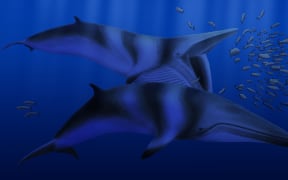Fossil discoveries by University of Otago palaeontology researchers have helped fill an important gap in the evolution of baleen whales.

Photo: 123rf
In the 1990s, Otago geologists found the fossils in the South Island's Waitaki River area, and a study about them has just been published in two science journals.
One of the lead researchers, Ewan Fordyce, said the fossils show two previously unknown species of filter-feeding baleen whales that lived 25 to 30 million years ago.
He said the findings add considerably to New Zealand's fossil record, and help fill evolutionary gaps between toothed ancestors and toothless modern baleen whales.
Professor Fordyce and Dr Robert Boessenecker's work appears in the Zoological Journal of the Linnean Society and the journal PeerJ.
The pair have named the newly described whale species Waharoa ruwhenua, Tokarahia kauaeroa.
They also discovered fossils of a poorly known species first found in the 1950s, which they were able to re-identify.
All the fossils are part of a whale family called eomysticetids, and the discoveries refer to some of the only mammals of their kind found in the southern hemisphere.
Professor Fordyce said it was great to see New Zealand material making a global impact in the world of ancient marine mammals.
"It's rather thrilling to discover that New Zealand is a bit of a Rosetta Stone for interpreting life in the ancient seas of the southern hemisphere," Professor Fordyce said.
He said the New Zealand specimens added diversity to what was already known about early 'dawn' baleen whales.
"They tell us much more about skull structure and the rest of the skeleton and give us much better insight into the lifestyle of these animals."
Adult sizes are estimated to be between five and six metres long - probably the size of, or a little bigger than, the modern minke whale.
Among the fossils was a juvenile skull which the researchers say suggests the area was potentially a calving ground.
Dr Boessenecker and Professor Fordyce found that Tokarahia kauaeroa had skeletal features falling between primitive toothed whales and modern baleen whales.
"This makes this whale a hallmark example of a transitional fossil," Dr Robert Boessenecker said.
"More importantly though, they fill in major gaps of knowledge - anatomy, growth, paleoecology - in whale evolution between 'toothy' archaeocete ancestors and toothless modern species," he said.


